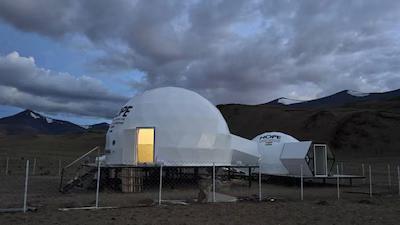
ISRO Sets Up Station in Ladakh to Simulate Life on Moon & Mars
The Indian Space Research Organisation (ISRO) has taken a significant step forward in its journey to explore the Moon and Mars by setting up a unique station in Ladakh’s Tso Kar Valley. The Himalayan Outpost for Planetary Exploration (HOPE) is a temporary facility that will test life-support systems for future lunar and Martian missions. This ambitious project is a testament to ISRO’s commitment to pushing the boundaries of space exploration and paving the way for human settlements in the harsh environments of other planets.
The HOPE station is designed to simulate the extreme conditions found on Mars, which is a crucial step in preparing for future manned missions to the Red Planet. The Tso Kar Valley was chosen for its unique features, which include high UV radiation, low atmospheric pressure, extreme cold, and saline permafrost. These conditions are eerily similar to those found on Mars, making it the perfect location for ISRO to conduct its simulation mission.
The HOPE station is a miniaturized version of a lunar or Martian base, with two crew members set to undertake various tests at the facility from August 1st to 10th. The crew will be subjected to a range of challenges, including isolation, confinement, and the harsh environment, to assess their ability to adapt and survive in such conditions.
The mission’s objectives are multifaceted, with a focus on testing the life-support systems, communication equipment, and emergency response protocols. The crew will also conduct scientific experiments to better understand the effects of radiation, temperature fluctuations, and other environmental factors on the human body.
One of the primary goals of the HOPE mission is to test the airlock, which is a crucial component of any space mission. The airlock will be used to simulate the process of entering and exiting the lunar or Martian base, and will be subjected to extreme temperatures, humidity, and atmospheric pressure.
The HOPE station is not just a temporary facility, but a permanent presence in Ladakh that will continue to play a crucial role in ISRO’s future missions. The organisation plans to use the station as a hub for conducting research and development, as well as a training facility for astronauts.
The HOPE mission is a significant achievement for ISRO, which has already made tremendous progress in its space exploration program. The organisation has successfully launched a range of satellites, including the Chandrayaan-1 mission, which orbited the Moon and discovered water ice on its surface.
ISRO’s plans to explore the Moon and Mars are well underway, with the organisation currently working on several missions, including the Chandrayaan-3 mission, which aims to land a rover on the Moon’s surface. The Gaganyaan mission, India’s first crewed spacecraft, is also set to launch in the near future, marking a major milestone in the country’s space program.
The HOPE mission is a testament to ISRO’s commitment to pushing the boundaries of space exploration and paving the way for human settlements in the harsh environments of other planets. As the organisation continues to make progress in its mission to explore the Moon and Mars, it is clear that the future of space travel is bright, and that India is well on its way to becoming a major player in the global space community.






